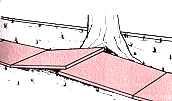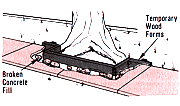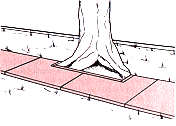Replacement
1. Break up the area to be replaced with a sledgehammer or pick. If the problem is a pavement section that has been uplifted by tree roots and cannot be simply relaid, break enough concrete off the corner to make a large notch to permit releveling of the section.

2. Relevel the gravel base if it has sunk; use the broken concrete as filler.
3. Brush the edges of the remaining concrete and wash with Concrete and Asphalt Cleaner to remove any organic refuse that might interfere with the repair's bond.
4. Apply the Concrete Bonding Adhesive to all exposed edges of the old concrete. Erect temporary forms along the edges.

5. Place the concrete and cure with QUIKRETEŽ Acrylic Concrete Cure & Seal.
For Best Results
- Use PRO FINISH QUIKRETEŽ Crack Resistant Concrete to eliminate damage caused by impacts or slight slab shifting or setting.
- When QUIKRETEŽ Concrete Mix is used, reinforcement can be added.
- When a notch has been cut out around a tree trunk, sink a border of treated 2 x 4s flush with the grade. They can also be used as forms for placing the concrete.

Repositioning
Walks can shift, settle and heave due to changes in the subgrade or pressure from tree roots. If the walk was built correctly, this cracking and movement should occur only at control and expansion joints, with complete sections of the walk remaining intact. In this case, the best repair method is to reposition the slab sections on a new base. If there is no cracking at the control joints, a chisel and small seldgehammer can be used to break the walk cleanly at these points. Wear heavy work gloves and be careful to to pinch your fingers or toes under the slab edge; the job will be easier if you have a helper.
1. Determine the desired finished height for the repositioned sections. String a mason's line at this height to give yourself a visual reference.
2. Use a long iron pry bar and small block of wood for lifting leverage. Never rest the pry bar directly on the adjacent concrete slab; the edge may chip or crumble under the pressure.
3. Use pieces of brick or flat stones to shim the slab to the correct level. Push them in place with a rake or board. Never put your arm beneath the raised slab. To allow for settlement, shim to a height slightly higher than required.
4. Once the slab is firmly supported on the bricks or stones, fill the voids beneath the slab with pea gravel.
|
